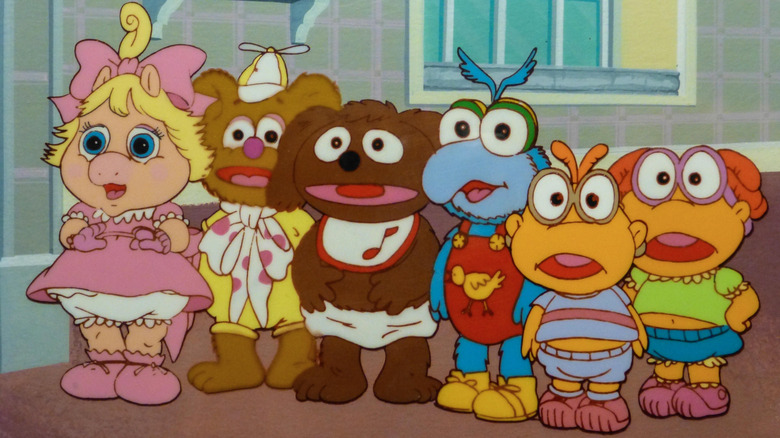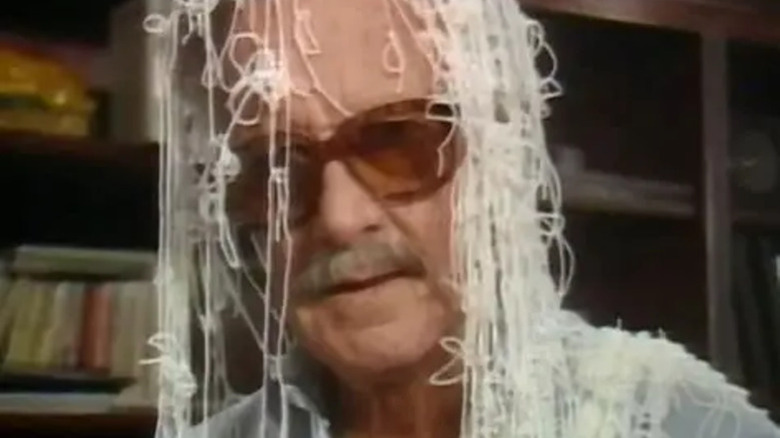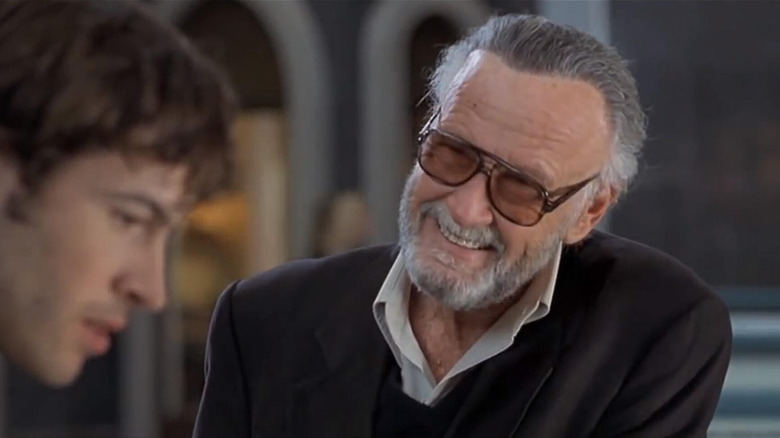One Of Stan Lee's Earliest Cameos Wasn't Even For A Marvel Property
The 1984 animated series "Jim Henson's Muppet Babies" was a spinoff of Henson's celebrated 1976 variety series "The Muppet Show," of course, but moreso, it was a TV adaptation of a dream sequence from 1984's "The Muppets Take Manhattan." In the movie, Miss Piggy (Frank Oz) fantasizes herself and her fellow Muppet performers as babies, singing a doo-wop song in a nursery. The sequence stands out because the baby Muppets are so damn cute.
The "Muppet Babies" animated series took those images and expanded them into a full-blown premise. In the TV show's world, the Muppets are all the same age, toddlers together in an expansive nursery, left alone to play all day. To fill the time, the Muppet Babies played imagination games, picturing themselves in dramatic roles or in harrowing circumstances. The show made extensive use of clips and live-action footage that the Muppet Babies would interact with. The tots' idylls were interrupted by the kind, matronly Nanny (Barbara Billingsley) whom audiences only saw from the knees down.
It was shocking how popular "Muppet Babies" was, lasting for 107 episodes over its eight seasons. Every kid watched it, taken by its light humor and cutesy character design. The immortal Frank Welker played Baby Kermit (and several other roles), while Laurie O'Brien played Baby Miss Piggy, the real star of the show. Baby Gonzo was played by Russi Taylor, Rowlf was played by Katie Leigh, and both Fozzie and Scooter by Greg Berg. Howie Mandel, once again employing his Gizmo/Bobby voice, played Scooter's twin sister Skeeter, a new character for the series. Dave Coulier from "Full House" voiced Animal and Bunsen.
The series was popular enough to warrant a few high-profile cameos, including Marvel Comics head honcho and creator of Spider-Man, Stan Lee. He appeared in live-action, and was sprayed with Spider-Man webbing.
Stan Lee played himself in an episode of Muppet Babies
In the episode "Comic Capers" (October 21, 1989), Rowlf and Skeeter are poring over old Spider-Man comics, debating over the medium's gender parity. Rowlf admires that he can live out a childhood power fantasy by projecting himself into Spider-Man's body. Skeeter notes that we can't see Spider-Man's face, and that he may very well be a woman under there. She calls the character Spider-Girl.
Rowlf proceeds to literally project himself into a Spider-Man comic, playing the role of Peter Parker. He appears in costume, unexpectedly runs into the Hulk, and then takes to the streets to interact with the real Spider-Man, realized through clips of the 1967 "Spider-Man" animated series.
"Muppet Babies" regularly played with the fourth wall, so Rowlf was seen literally swinging off of the page. He needed Spider-Man to instruct him how to move from panel to panel. Skeeter then infiltrates the comic as well, dressed as Spider-Girl. Rowlf and Skeeter begin firing webbing at one another, arguing over Spider-Man's perceived gender.
There is then a smash cut to a small drawing board in a live-action comic book studio. The webbing fires up out of the page, hitting the illustrator's hand. It's Stan Lee! Lee looks down into the page and being to admonish Rowlf and Skeeter for their rowdy behavior. "Hey, you kids," he says, "cut that out!" They don't listen and spray long strings of webbing directly at his face. Clearly the webbing is pre-canned Silly String. Dripping with the stuff, Lee merely says "Oh, boy." The clip of Lee's cameo can be found easily enough online.
A brief history of Stan Lee cameos
This was only Lee's second on-screen cameo ever, following his appearance in the TV movie "The Trial of the Incredible Hulk," which also aired in 1989, the previous May. He had served as the narrator for the 1960s-era Marvel animated shorts, of course, but didn't appear in anything on camera until "Trial."
Stan Lee cameos became a mainstay throughout Marvel TV and film history, of course, but it's rare that he would do something outside the company. Although "Muppet Babies" was co-produced by Marvel Animation, so it was at least tangentially connected. Lee would only occasionally appear on TV or in films, usually as himself, sometimes as a surreal aside. He played himself in Larry Cohen's 1990 thriller "The Ambulance," a movie about a comic book author in search of his potentially kidnapped date. Starting in the 1990s, though, Lee developed a taste for poking his head into every Marvel Comics-related film or TV show that he could, turning up in "X-Men," "Spider-Man," "The Fantastic Four," and other noted animated shows of the era. His best role was in Kevin Smith's 1995 film "Mallrats," playing himself, yes, but there to give romantic advice to the callow Brodie (Jason Lee, no relation).
Once special effects and budgeting finally allowed Marvel heroes to reach the big screen in the early 2000s, Lee became a gadfly, appearing in most Marvel productions, good and bad. Lee's cameos throughout the Marvel Cinematic Universe are a matter of mass knowledge. His final role was in a "Star Trek" fan short called "Starship Farragut Homecoming," released in 2021, three years after his death.


